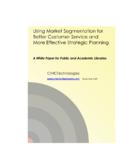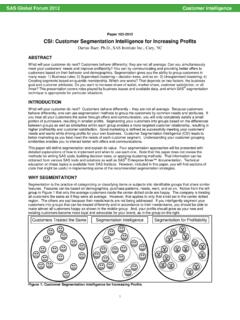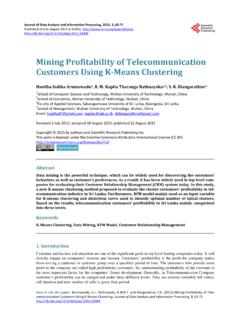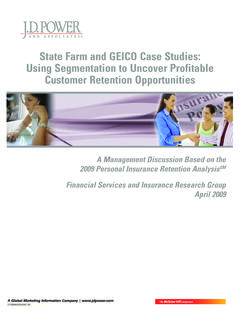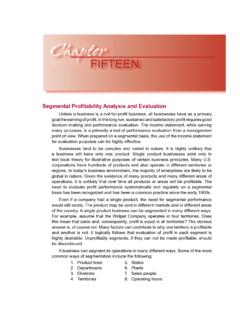Transcription of Calculating and Reporting Customer Profitability - …
1 APQC. Calculating and Reporting Customer Profitability Final Report A Consortium Benchmarking Study Jointly Conducted By: And Subject Matter Expertise Provided By: John A. Miller Director APQC. TABLE OF CONTENTS. PAGE. EXECUTIVE SUMMARY I. CHAPTER 1: BACKGROUND AND OVERVIEW OF Customer Profitability 16. INITIATIVES AT PARTICIPANT ORGANIZATIONS. CHAPTER 2: Customer SEGMENTATION 26. CHAPTER 3: Calculating Customer Profitability 38. CHAPTER 4: Reporting Customer Profitability 55. CHAPTER 5: PUTTING Customer Profitability INTO ACTION 64. APQC. FIGURES. PAGE. : ORGANIZATION OF FINAL REPORT 3. : APQC'S FOUR-PHASED BENCHMARKING METHODOLOGY 4. : INDUSTRIES REPRESENTED 7. : UNIT OF PARTICIPATION 8. : PRIMARY CUSTOMERS 9. : ESTIMATED ANNUAL GROSS REVENUES FOR MOST RECENT FY 10. : ESTIMATED TOTAL NUMBER OF EMPLOYEES FOR MOST RECENT FY 11.
2 : ESTIMATED NUMBER OF UNIQUE PRODUCTS/SERVICES SOLD 12. : FREQUENCY OF PURCHASE OF PRODUCT/SERVICE 13. : LENGTH OF TIME Calculating AND Reporting CUST. Profitability 17. : ESTIMATED % OF PROFITS PROVIDED BY TOP 20% OF CUSTOMERS 18. : PRIMARY CATALYST FOR Customer Profitability INITIATIVE 19. : FUNCTION WITH PRIMARY ACCOUNTABILITY FOR CP CALCULATION AND 21. Reporting . : KEY STAKEHOLDERS INVOLVED IN CP CALCULATION AND Reporting 23. : APPROXIMATE NUMBER OF PEOPLE INVOLVED IN CP CALCULATION AND 24. Reporting . : PARTICIPANTS' CUSTOMERS 27. : CHANNEL COMPLEXITY 28. : INTEGRATED Customer VIEW AS FOUNDATION OF CRM AT FEDEX 29. : Customer AGGREGATION INTO ENTITIES AT FEDEX 30. : DEFINING Customer RELATIONSHIPS AT WACHOVIA 31. : SUBSEGMENT CUSTOMERS? 32. : NUMBER OF MACRO Customer SEGMENTS 34. : BASIS OF Customer SEGMENTATION 35.
3 : WACHOVIA CONSUMER MARKETING SEGMENTS 36. : TIERED SEGMENTATION AT FEDEX 37. : ESTIMATED NUMBER OF CUSTOMERS 42. : CALCULATE COST TO SERVE FOR THE FOLLOWING? 43. : DETERMINING POTENTIAL Customer VALUE AT FEDEX 45. : DETERMINING POTENTIAL MEMBER VALUE AT NSCU 47. APQC. : ESTIMATE Profitability OF PROSPECTS/LEADS? 49. : COSTS INCLUDED IN Customer Profitability CALCULATION 50. : COST ALLOCATION METHODOLOGY 52. : VENDORS OF ENABLING TECHNOLOGIES FOR Customer Profitability 53. CALCULATION AND Reporting . : SAMPLE ZIPPO Customer PROFIT AND LOSS STATEMENT 56. : Customer Profitability METRICS REPORTED AT ZIPPO 57. : EMPLOYEES RECEIVING Customer Profitability INFORMATION 59. : MECHANISMS FOR DISSEMINATING Customer Profitability 62. INFORMATION. : LESSONS LEARNED/CRITICAL SUCCESS FACTORS IN Calculating AND 65.
4 Reporting Customer Profitability . : Customer Profitability TIED TO EMPLOYEE PERFORMANCE 67. OBJECTIVES AT THE FOLLOWING LEVELS. : Customer Profitability TIED TO EMPLOYEE COMPENSATION AT THE 68. FOLLOWING LEVELS. : AREAS Customer Profitability IS USED AS AN INPUT 69. : IMPACTS OF ENTERPRISE SEGMENTATION AT FEDEX 70. : SUCCESSFULLY CONVERT UNPROFITABLE CUSTOMERS TO PROFITABLE 74. CUSTOMERS? : DEMONSTRATE WORTHWHILE ROI ON Customer Profitability 75. EFFORTS? APQC. EXECUTIVE SUMMARY. N ot all customers are created equal. More and more, leaders are viewing business as an investment We're not everything to everybody as a community credit union. We expect the portfolio of customers, some more relationship to be mutually beneficial. valuable than others, with the level of CIO, North Shore Credit Union investment delivered commensurate to (Source: Profits, One Customer at a the level of Customer value.)
5 The Time, CRM Magazine, January 1, 2005). Profitability of the Customer mix is becoming more important than profits of the individual products. This approach is a significant shift from traditional product-, service-, geography-, territory-, and function- based organizations. Executives are discovering the benefits of enhancing their Customer investment portfolio by creating and executing competitive Customer value propositions. In their book Killer Customers: Tell the Good from the Bad Crush Your Competitors (Portfolio, 2004), authors Larry Selden and Geoffrey Colvin estimate that the top 20 percent of customers (by Profitability ) typically generate more than 120 percent of an organization's profits. By comparison, the bottom 20 percent of customers typically generate losses equaling more than 100 percent of profits, leaving a net 20 percent for all customers combined.
6 Sustaining the top 20 percent and improving the bottom 20 percent will significantly improve the bottom line of any While many organizations see the potential value of Calculating and Reporting Customer Profitability , not all areas are equally problematic to the organization. Once an organization can identify their Customer segments, then what? Typically, the organization will want to know which customers in the segment are profitable and which ones are not. Without understanding how different customers consume costs and resources, organizations cannot successfully calculate Customer Profitability . The purpose of the Calculating and Reporting Customer Profitability consortium benchmarking study was to identify and share best practices for Customer Profitability models, cost allocation methodologies, communicating Customer Profitability information, and using Customer Profitability to make more effective business decisions.
7 Analyzing the Profitability of the Customer portfolio and understanding each Customer and Customer segment is fundamental for the management of the business and is a critical part of being Customer -centric. 1 Source: Killer Customers: Tell the Good from the Bad and Crush Your Competitors, by Larry Selden and Geoffrey Colvin, Penguin Group Inc., 2003. 2005 APQC 1 Final Report APQC. S TUDY S COPE. Drawing on input from the subject matter expert and secondary research, the APQC. study team identified three key areas for research. These areas guided the design of the data collection instruments and were the basis on which the study findings have been developed. 1. Segment customers. Sort with various segmentation techniques to identify the winners from the losers.. Target marketing and sales efforts to Customer segments that improve return on investment.
8 Understand the assets and investments required to service customers and Customer segments. Execute competitive Customer value propositions in each Customer segment. 2. Understand the cost to service Customer segments through the use of cost- tracing methods. Recognize the cost differences for servicing customers. Customers purchase online;. by mail, telephone, or fax; or by visiting a physical location. They will frequently order in small lots or place large, single orders. The cost-to-serve differences can be substantial. Determine the appropriate level of Customer support. Some Customer segments require substantial support, while others require very little. Determine methods to calculate the cost to serve and the incentives that can change Customer behavior. 3. Report Customer Profitability . Use Customer Profitability information to make effective business decisions.
9 Establish Customer Profitability Reporting as the foundation for being Customer - centric. Use Customer Profitability as a method to drive organizational change. This final report is organized to correspond with these study scope areas as depicted in Figure , page 3, which is also a high-level model for how to calculate and report Customer Profitability . Chapter 1 summarizes background information and describes the approaches for Customer Profitability calculation and Reporting at study best-practice partner organizations. Chapters 2, 3, and 4 correspond to the study scope. Finally, Chapter 5 describes how Customer Profitability information is made actionable at study best-practice partner organizations. Greater detail on the practices at any individual study best-practice partner can be found in their corresponding site visit summary.
10 2005 APQC 2 Final Report APQC. Organization of Final Report Business and management requirements Ch. 5: Putting Ch. 3: Calculating Ch. 2: Customer Ch. 4: Reporting Customer Customer segmentation Customer Profitability Profitability into Profitability action Figure The following key findings, or themes, emerged from this consortium benchmarking study. Chapter 1: Background and Overview of Customer Profitability Initiatives at Participant Organizations Key Finding 1: At best-practice organizations, Customer Profitability is owned by marketing, with finance as a key stakeholder. Key Finding 2: Study participants have defined a small, dedicated group of anywhere from two to five individuals who are involved in Calculating and Reporting Customer Profitability . Chapter 2: Customer Segmentation Key Finding 3: Best-practice partners have developed an enterprise-wide view of the Customer .

